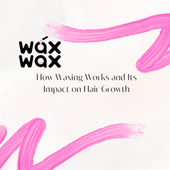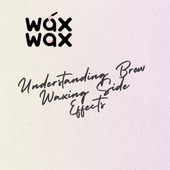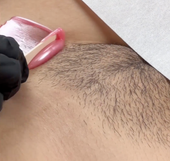How to Remove a Deep, Painful Ingrown Hair (Safely)
Compartir

TL;DR: What to Do About a Deep Ingrown Hair
Here's the short, safe answer for our WaxFam:
- STOP! Put the Tweezers Down. Do NOT try to dig, squeeze, or pick at a deep, painful, or swollen ingrown hair. You are very likely to cause a serious infection or a permanent scar.
- Your #1 Tool: A warm compress. Soak a clean cloth in warm water and hold it on the bump for 15 minutes, several times a day. This will soothe the pain and help the hair come to the surface on its own.
- Know When to Stop: If the bump is very painful, swollen, or feels hot to the touch, and you cannot see the hair, it is beyond DIY.
- The Only Solution: See a professional. A licensed esthetician or dermatologist has the sterile tools and training to safely extract it.
Hello WaxFam! Is That Ingrown Hair Really Painful?
Hey, WaxFam. We need to have a serious talk. You've got an ingrown hair, but it's not a normal one. This one is deep, it's swollen, and it hurts. You're probably in your bathroom right now, tweezers in hand, ready to go "treasure hunting."
Please, for the love of smooth skin, stop.
At Wax Wax, we're the #1 specialist in hard wax for sensitive skin. Our professional-grade, Made in Italy hard wax is designed to give you a clean pull from the root to prevent this exact situation. But if you're here, you're past prevention and in the "panic" stage.
As skin experts, our #1 priority is your safety. "Bathroom surgery" is the fastest way to turn a temporary bump into a permanent, pitted scar or a nasty staph infection. This article is your official "Don't Be a Bathroom Surgeon" guide. We'll show you the safe way to soothe it, and when to call a pro.

The Danger: Why You Must Not Dig
A "normal" ingrown hair is a simple mechanical problem. A "deep, painful" ingrown hair is different. The pain and swelling mean your body is fighting a major battle.
- You Can't See the "Enemy": The hair is buried deep below the skin. When you start digging with tweezers, you aren't grabbing the hair—you're ripping up healthy skin.
- You'll Cause Infection: Your tweezers and fingers are not sterile. You are about to introduce bacteria deep into a warm, open wound. This is how a simple ingrown turns into an infected cyst or abscess.
- You'll Create a Scar: Squeezing and digging will rupture the follicle wall under the skin, spreading the infection and permanently damaging the tissue. This is what leaves those little "ice pick" or pockmark scars.
Phase 1: The "Soothe, Don't Dig" Method
Your only job is to calm the inflammation and soften the skin. Do not try to be a hero.
- Start with a Warm Compress: This is your best and only safe tool. Soak a clean washcloth in warm (not scalding) water and hold it on the bump with light pressure for 15 minutes.
- Repeat, Repeat, Repeat: Do this 3-4 times a day. The warmth will increase blood flow to the area, soothe the inflammation, and (hopefully) encourage the hair to work its way to the surface on its own.
- Spot Treat (Gently): After your compress, you can apply a gentle spot treatment, like our Ingrown Hair Lotion, which contains chemical exfoliants to help dissolve the dead skin that's trapping the hair.
- Keep it Clean and Dry: In between compresses, keep the area clean, dry, and let it breathe.

The "Red Light / Green Light" Extraction Test
Use this professional checklist. If you hit a single "Red Light," you must stop immediately.
| Symptom | 🔴 RED LIGHT (STOP! SEE A PRO) | 🟢 GREEN LIGHT (You may *gently* proceed) |
|---|---|---|
| Visibility | You **cannot** see the hair. It's a "blind" bump. | You can **clearly** see a hair loop resting *above* the skin's surface. |
| Pain Level | It's very painful, throbbing, or hot to the touch. | It's a small, itchy, or annoying bump with low-level redness. |
| Pus / Infection | The bump is large, hard, or has a large, greenish/yellow head. | There is no pus, or just a tiny "pinprick" whitehead. |
| Your Tool | You are about to use your fingers or a dull, unsterilized tool. | You have sterilized, fine-point tweezers. |
| The Action | You have to *break* the skin to get to the hair. | You are just gently *lifting* the visible loop. |
If you are 100% in the "Green Light" zone, you can read our main guide on how to treat ingrown hair for safe removal steps. But if you hit even one "Red Light," your journey ends here.

When to See a Professional (And Why It's Worth It)
If your bump is deep, painful, and inflamed, you don't have an ingrown hair "problem"—you have a skin infection. This could be severe folliculitis after waxing or a cyst.
- Go to an Esthetician: A licensed esthetician is a trained skin expert. They have sterile extraction tools, magnifying lamps, and high-frequency devices to kill bacteria and safely remove the hair without scarring.
- Go to a Dermatologist: If the bump is extremely large, hard, and painful, you may need a medical professional. A dermatologist can drain the cyst safely or, in some cases, inject it with cortisone to rapidly shrink the inflammation.
What This Means for You
For our WaxFam (At-Home Users): Your skin's health is worth more than the five seconds of "satisfaction" you'll get from digging. Trust us. Be the pro. Choose the "soothe" method, and if it's a "Red Light" problem, let a real pro handle it. Your future, scar-free skin will thank you. Once it's healed, focus 100% on a prevention routine.
For our WaxFam Pro (Estheticians & Salon Owners): This is a critical moment to build client trust. When a client calls you with this problem, tell them, "Do not touch it. Come in." This positions you as the expert savior. This is your chance to be the hero, safely fix their problem (check our esthetician's troubleshooting guide), and then retail them the prevention products so it never happens again. This is how you create a loyal client for life. Always ensure your back bar is stocked with professional hard wax wholesale and all the aftercare they'll need.

Frequently Asked Questions
What's the difference between a deep ingrown hair and a cyst?
A deep ingrown hair causes a cyst. The cyst is your body's reaction—it's a sac-like pocket of fluid and infection that your body builds to "wall off" the trapped hair. At this point, it's a medical issue.
Can I put a pimple patch on a deep ingrown hair?
It won't hurt, and it might help! A hydrocolloid patch can help pull moisture and pus to the surface (just like it does for a pimple), which might help the hair surface. It's a much safer alternative to picking.
Will it eventually go away on its own?
Often, yes. Your body is smart. It will either eventually "push" the hair out, or it will break down and absorb the hair over time. But this can take weeks or even months, and it may leave a dark spot (hyperpigmentation).
What if I already picked at it and made it worse?
Stop immediately. Clean the area with a gentle antiseptic (like witch hazel) or soap and water. Apply a dab of antibiotic ointment (like Neosporin) and cover it with a bandage. Do not touch it again.
How do I prevent this from ever happening again?
Prevention is the only cure. Once this is healed, you must start a 2-Phase prevention routine: 1. Physical exfoliation with Exfoliating Gloves and 2. Chemical exfoliation with a product like our Ingrown Hair Lotion.
Our Final Word: Be Kind to Your Skin
So, WaxFam, step away from the mirror. Put down the sharp objects. Your body is trying to tell you something, and "digging" is not the answer.
Treat the area with gentle, soothing care, and if it's a "Red Light" problem, trust a professional to solve it. A moment of patience now will save you from a month of irritation or a lifetime of scarring.
Related Posts
-
How to Properly Position Clients for Waxing: The Pro-Esthetician's Guide
TL;DR: For the Busy WaxFam Pro Here’s the high-level summary of professional positioning: It's Not Just Comfort, It...
-
What Is the Best Lotion for Preventing Ingrown Hairs? A Pro's Guide
TL;DR: The Pro-Grade Solution Here’s what to look for when you're shopping for the "best" lotion: It's a "Treatment...
-
Infected Ingrown Hair vs. Pimple: How to Tell the Difference
TL;DR: What Your Bump Is Telling You Here’s the fast guide to identifying that mysterious red bump: Is it a Pimple?...
-
How to Exfoliate to Prevent Ingrown Hairs (The Pro Guide)
TL;DR: The Pro-Exfoliation Method Here's the quick guide to stopping ingrown hairs before they start: Why Exfoliate...
-

Are Dyes in Hard Wax Safe? A Guide to Hypoallergenic Formulas
TL;DR: Are Dyes in Wax Safe? Here’s the short answer for our busy WaxFam: Not all dyes are bad, but low-quality, har...
-

The Real Secret to Waxing Salon Client Retention
TL;DR Client retention isn't just marketing; it's built into the core of your waxing service, starting with the pr...
-

The Ultimate Guide to Waxing Techniques
TL;DR Mastering waxing techniques means understanding more than just pulling hair. It’s about a holistic process: ch...
-

Guía de solución de problemas para esteticistas: Cómo solucionar las 5 reacciones cutáneas más comunes después de la depilación
TL;DR / Resumen ejecutivo Las reacciones cutáneas posteriores a la depilación pueden minar la confianza del cl...
-

Cómo realizar ventas adicionales y cruzadas de productos minoristas de manera eficaz en su salón
TL;DR / Resumen ejecutivo La venta adicional y cruzada de productos minoristas en su salón de depilación puede...
-

Los más altos estándares de higiene y saneamiento para un salón de depilación
TL;DR / Resumen ejecutivo Mantener los más altos estándares de higiene y saneamiento es fundamental para los s...
-

La ciencia de la sensibilidad: un análisis profundo de los ingredientes hipoalergénicos de las ceras duras WaxWax.com
TL;DR / Resumen ejecutivo La seguridad y la satisfacción del cliente son primordiales en un salón de depilació...
-

Procedimientos operativos estándar obligatorios (POE) para un salón de depilación moderno
TL;DR / Resumen ejecutivo Implementar Procedimientos Operativos Estándar (POE) sólidos es esencial para que un...
-

Consideraciones clave en un contrato de franquicia y documento de divulgación
TL;DR / Resumen ejecutivo Abrir una franquicia de depilación y comenzar un negocio de depilación requiere un p...
-

Cómo aprovechar las redes sociales (Instagram, TikTok) para tu salón de depilación
TL;DR / Resumen ejecutivo Las plataformas de redes sociales como Instagram y TikTok son herramientas poderosas...
-

Consejos para reclutar, capacitar y retener a esteticistas profesionales
TL;DR / Resumen ejecutivo Reclutar, capacitar y retener a esteticistas profesionales es fundamental para el éx...
-

Guía de permisos y licencias comerciales necesarios para abrir un salón
Resumen Abrir una franquicia de salón de depilación y depilación requiere gestionar una compleja red de permis...
-

Análisis del potencial de ganancias y el ROI de una franquicia de belleza
TL;DR / Resumen ejecutivo Invertir en una franquicia de salón de belleza ofrece un potencial de ganancias cons...
-

Las 10 preguntas más frecuentes sobre franquicias de depilación con cera
TL;DR / Resumen ejecutivo Explorar una oportunidad de franquicia de depilación puede ser un cambio radical para ...
-

Los 5 principales desafíos que enfrentan las empresas de depilación y cómo las franquicias pueden ser la solución
TL;DR / Resumen ejecutivo Los negocios de depilación enfrentan desafíos importantes que pueden obstaculizar la r...
-

Guía paso a paso para elegir una ubicación estratégica para un salón de depilación
TL;DR / Resumen ejecutivo Seleccionar la ubicación perfecta para su salón de depilación es una decisión fundamen...
-

Franquicia vs. Salón de depilación independiente: Análisis de ventajas y desventajas
TL;DR / Resumen ejecutivo Decidir entre una franquicia o un salón de depilación independiente es una decisión cr...
-

Un desglose completo de los costos iniciales para abrir un salón de depilación
TL;DR / Resumen ejecutivo Abrir un salón de depilación requiere una planificación financiera cuidadosa para gara...
-

Guía completa para franquiciados de depilación con cera (2025)
TL;DR / Resumen ejecutivo Iniciar una franquicia de depilación en 2025 exige un enfoque estratégico para garanti...
-

Beneficios del té de caléndula para la piel al depilarse: Tu guía de WaxFam para una piel suave y aliviada
Hola WaxFam, ¡vamos a calmar vuestra piel con caléndula! ¡Hola, WaxFam! ¿Lista para mejorar tu depilación con un...
-

Rutina de cuidado de la piel para un escote juvenil de Wax Wax
Hola WaxFam, ¡vamos a darle brillo a tu escote! ¡Hola, WaxFam! ¿Lista para darle a tu escote el tratamiento estr...
-

Cómo elegir la mejor cera dura para depilar las cejas
Hola WaxFam, ¡vamos a esculpir esas cejas correctamente! ¿Qué tal, WaxFam? ¿Lista para realzar tus cejas con arc...
-

Preparación para la depilación de cejas: consejos para una experiencia impecable
Hola WaxFam, ¡prepárate para unas cejas perfectas! ¿Qué tal, WaxFam? ¿Lista para esculpir tus cejas y lograr arc...
-

Cuidados posteriores a la depilación de cejas: Cómo suavizar y mantener unas cejas perfectas
Hola WaxFam, ¡mantengamos esas cejas impecables! ¡Hola, WaxFam! ¿Te acabas de depilar las cejas y te sientes incre...
-

Errores comunes al depilarse las cejas (y cómo evitarlos con cera dura)
Hola WaxFam, ¡vamos a conseguir esas cejas perfectas! ¡Bienvenidos, WaxFam, a tu guía para una depilación...
-

¿Puedes ducharte después de la depilación? Guía WaxFam para el cuidado post-depilación
¿Qué tal, WaxFam? ¿Recién depilada y con una sensación fabulosa? En Wax Wax, nos dedicamos a ofrecerte la piel más ...
-

¿Puedes depilarte durante la regla? Guía WaxFam para una confianza plena
¡Hola, WaxFam! Ya sea que te estés preparando para un día de playa o simplemente quieras tener una piel suave, Wax ...
-

¿La depilación con cera ralentiza el crecimiento del vello? La verdad revelada para WaxFam
¡Bienvenidos, WaxFam, a otra inmersión profunda en el mundo de la piel suave y radiante! En Wax Wax, nos dedicamos ...
-

Depilación de cejas para hombres: Cómo abordar los efectos secundarios con las soluciones de cera dura de WaxWax
Hola WaxFam, ¡hablemos de depilación de cejas para hombres! Bienvenido a la familia WaxWax, donde nos dedicamos ...
-

¿Infecciones después de la depilación? Aquí te explicamos cómo prevenirlas y tratarlas naturalmente con WaxWax.
¡Hola, WaxFam! Hablemos de las infecciones después de la depilación (y cómo evitarlas) Lo entendemos, WaxFam: la...
-

Cambios en la pigmentación después de la depilación: causas, soluciones y cómo WaxWax puede salvar tu piel.
Hola WaxFam, ¡brillemos sin problemas de pigmentación! ¿Qué tal, WaxFam? ¿Lista para lucir un brillo suave y sin...
-

Daños graves en la piel después de la depilación: efectos secundarios, soluciones y cómo la cera puede salvar el día.
Hola WaxFam, ¡hablemos de los problemas y los éxitos de la depilación! ¡Bienvenido al ambiente WaxWax, donde una...
-

Reacciones alérgicas e inmunitarias a la depilación con cera: Tu guía para una piel suave y segura con WaxWax
Hola WaxFam, ¡dile adiós a los problemas de depilación con WaxWax! ¡Bienvenido al ambiente WaxWax, donde la piel...
-

Foliculitis después de la depilación: causas, prevención y tratamiento para una piel suave y radiante
WaxFam, lo entendemos: nada supera los resultados sedosos y duraderos de una depilación fresca. ¿Pero esos molestos...
-

Guía para WaxFam sobre la normativa de cera dura en Canadá: 2025
¡Hola WaxFam! Tanto si eres un esteticista profesional que domina la depilación con cera para sus clientes como si ...
-

Cera dura para piel sensible: las mejores opciones recomendadas por dermatólogos canadienses
¡Hola, WaxFam! La piel sensible puede ser una batalla en el clima extremo de Canadá, donde los inviernos gélidos y ...
-

Cera dura ecológica en Canadá: belleza sostenible para consumidores conscientes
¡Hola WaxFam! Los canadienses están a la vanguardia de la belleza ecológica, y la cera dura vegana y ecológica está...
-

La guía definitiva para canadienses sobre depilación durante todo el año: datos, consejos y estrategias según la temporada
¡Hola WaxFam! Una piel suave no es solo para el verano: la depilación con cera durante todo el año te mantiene radi...
-

Depilación en invierno en Canadá: Las mejores opciones de cera dura para pieles secas y sensibles
¡Hola WaxFam! Los inviernos canadienses son implacables: vientos gélidos, temperaturas bajo cero y el calor seco en...
-

Estilos de depilación femenina: tendencias, datos y perspectivas
¡Hola WaxFam! ¡Bienvenidas a tu guía definitiva sobre estilos de depilación para mujeres! La depilación con cera es...
-

Qué no hacer antes de una depilación brasileña
¡Hola, WaxFam! Les damos la bienvenida a otra inmersión profunda en el mundo de la depilación suave, segura y sin p...
-

¿Por qué la depilación brasileña se llama brasileña?
¡Hola, WaxFam! Les damos la bienvenida a otra exploración a fondo de Wax Wax, su marca de referencia para todo lo r...
-

Cuidados después de la depilación: consejos esenciales para una piel suave y radiante
¡Hola WaxFam! Tanto si eres una usuaria que domina la depilación en casa como si eres una esteticista profesion...
-

Cera Hollywood: tu guía completa para un acabado sedoso
¡Hola, WaxFam! Bienvenidos de nuevo a otro blog repleto de información de Wax Wax, la marca dedicada a ayudarte a c...
-

Alternativas a las máquinas de cera: nuevas formas de derretir cera
¡Hola, WaxFam! Bienvenidos a otra inmersión profunda de Wax Wax, tu fiel aliado en el mundo de la piel suave como l...













































